
‘Columbia’ Captures the 1958 America's Cup
In a new class of boats, americans continue to dominate a century-old race.
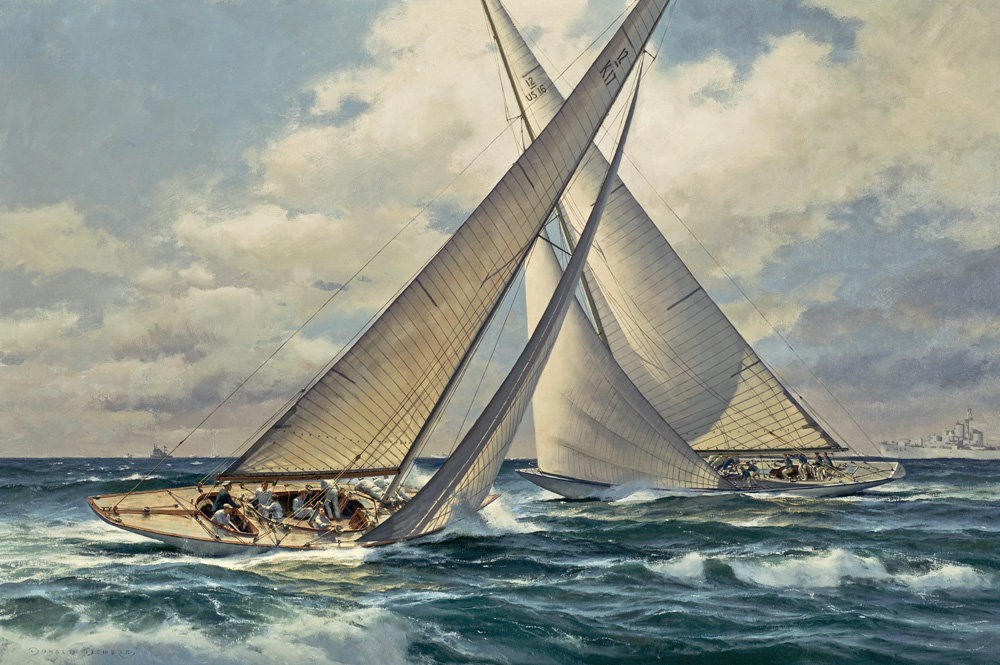
The year was 1958 and the America’s Cup held its first race in over 20 years, the longest gap between challenges in the history of the ocean-going competition. The Royal Yacht Squadron (RYS), the challenger, launched their newly-christened Sceptre from the Scottish docks. The New York Yacht Club (NYYC), the defender, answered with the Columbia , a boat constructed on City Island in the Bronx.
In the waters off Newport, Rhode Island, Columbia ended up sweeping its rival 4-0.

Sceptre ’s heavy defeat resulted in great disappointment across the Atlantic where hopes for victory on the waves were once again dashed. A combination of factors was cited for her underwhelming results, including inadequate test trials at home. For the U.S., superior yacht design and masterful skills against the wind were proven once again in a new class of boats. Americans would keep defending the Cup successfully with the 12-meters until 1983 when the Royal Perth Yacht Club sailed the Australia II to victory, putting an end to the NYYC’s 132-year reign.
ENJOY OUR CONTENT? SIGN UP FOR OUR FREE WEEKLY NEWSLETTER AND SHARE ON YOUR SOCIAL MEDIA
SPORTS HISTORY MAGAZINE in DIGITAL

Winter 2020

Spring 2020

Spring 2021

Winter 2021

Shop For Our Books & DVD's
BRIGGS CUNNINGHAM: American Racing Tradition TALE OF AN AMERICAN SPORTSMAN
The america's cup, the america’s cup – 1958, text by kane rogers.
View photographer Cory Silken’s “Yacht Columbia – America’s Cup Winner 1958” gallery here .
Click here to read “The America’s Cup: An Insider’s View,” by Bob Bavier.

Prior to 1958, the last defense of the America’s Cup had been in 1937, by the J-Class yacht Ranger , owned by Harold S. “Mike” Vanderbilt. The J-Class rules prescribing a vessel of some 120 feet in length were promoted by Vanderbilt and others for the defense planned for 1958, but economic concerns and the desire among aspiring competitors to employ smaller dual-purpose yachts won the day. The New York Yacht Club settled on the twelve-meter class rules, reducing the length of the average vessel to around sixty-five feet. Harry Sears, then the club’s commodore, formed a syndicate to build the ship and asked Briggs to join to help with finances.
Although building and racing his cars had long been Briggs’ primary field of endeavor, he had never stopped sailing, and he agreed to join the effort. Sailing legend Cornelius Shields was appointed as the team’s skipper but, when he suffered a heart attack, Sears asked Cunningham to take Shields’ place.
As a member of five East Coast yacht clubs, with almost thirty years’ experience racing several different classes of vessel, Briggs was a solid choice to lead. The one thing he lacked was experience with the starting strategy required by the head-to-head style of America’s Cup competition. Shields, a master of this type of racing, was happy to impart his knowledge to Cunningham, who proved an able student.
Unfortunately, as skipper it was Briggs who had to inform Shields that he could not remain a member of the crew; if he suffered an attack during competition and had to be taken to the hospital, it would leave them a man short and result in their disqualification. It was a tough moment for both men, but it was also characteristic of both to do what was best for the team.
The eliminations for the American side would prove to be more exciting than the final races. Four twelve-metre yachts, Easterner , Weatherly , Vim and Columbia , survived two months of run-offs to compete in the final eight-day round of match races to determine the defender of the America’s Cup. Of the four contenders, only the Vim had raced previously, but the nineteen-year-old vessel was so completely refitted as to be virtually brand new. The Easterner and Weatherly had been hurriedly completed and neither was fully prepared to compete, although the Weatherly would successfully defend the Cup in 1962.
Columbia benefited from a strong syndicate whose membership included Harry Sears, Olin Stephens, the designer of the Vim , and Cornelius Shields, Jr., who occasionally spelled Briggs as skipper. The competition finally narrowed to Vim and Columbia , which prevailed by virtue of her ability to better handle rough seas and strong winds.
The British challenger, Sceptre , entered by the Royal Yacht Squadron and skippered by Graham Mann, was a quite rotund 68,000 pounds compared to the svelte Columbia at 57,000 pounds, and the event was decided in four straight wins by the Americans.
During the post-race celebrations, Briggs located a pay phone and called Alfred Momo at Watkins Glen, where Ed Crawford had just won the main race. As Briggs was returning to join his crew, a reporter approached and commented, “Briggs, that was a fine race!” to which Briggs, still with the Glen on his mind, replied, “That’s what I just heard. I wish I could have seen it.”
Website Disclaimer
Please read the disclaimer prior to entering this website. You may access it by clicking here .

America’s Cup Yacht “Columbia”
LOA: 131′ 0″ LWL: 89′ 8″ Beam: 24′ 0″ Draft: 19′ 9″ Original Rig: Cutter Hull Number: 499 Designer: N.G. Herreshoff Contracted By: Iselin Syndicate Contract Date: 9/28/1898 Original Price: $ 90,000 Status: Destroyed

Related posts:
- Herreshoff America’s Cup Yacht “Colonia”
- America’s Cup Yacht “Vigilant”
- America’s Cup Yacht “Defender”
- America’s Cup Yacht “Resolute”
Leave a Comment Cancel
Your email address will not be published. Required fields are marked *
Email Address:
Save my name, email, and website in this browser for the next time I comment.
This site uses Akismet to reduce spam. Learn how your comment data is processed .

- Meet the ITMA Team
- Class Rules
- Class By-Laws
- 12mR Database
- Measurement Certificates
- The 12mR Class by Luigi Lang & Dyer Jones- Volume 1
- The 12mR Class by Luigi Lang & Dyer Jones- Volume 2
- 2024 PORQUEROLLES
- 2023 NEWPORT
- 2021 HELSINKI
- 2019 NEWPORT
- 2014 BARCELONA
- 2011 FLENSBURG
- WORLD CHAMPIONS
- 2017-2019 Series
- 2021 Regattas
- 2020 Regattas
- 2019 Regattas
- 2018 Regattas
- 2017 Regattas
- 2016 Regattas
- 2015 Regattas
- 2014 Regattas
- 2013 Regattas
- 2012 Regattas
- 2011 Regattas
- AMERICAS FLEET
- NORTHERN EUROPE FLEET
- SOUTHERN EUROPE FLEET
- Americas Fleet
- N. Europe Fleet
- S. Europe Fleet
- Coupe de France Series
- AZZURRA III (I-10)
- CRUSADER (K-24)
- LEGACY (KZ-5)
- VANITY V (K-5)
- VICTORY ’83 (K-22)
- WINGS (K-15)
- 12mRs for Charter
- 12mR Brand Guide
- 12mR Team Store
Columbia, US-16

Built in 1958 according to the International Third Rule.
1958-1962: Built for the 17th America’s Cup campaign at a cost of $300,000, her design was a development of Vim. She was slightly longer on the waterline with reduced sail area, but this was compensated by the efficiency of newer sails (later Dacron) and the reduced thickness (resistance) of her keel. Briggs Cunnigham skippered her to victory at the Defender Trials over Weatherly , Easterner and Vim and ultimately to a 4-0 win over Sceptre for the America’s Cup. In 1960 she was sold to Paul Shields, who altered her keel, she participated in the Defender Trials for the 1962 America’s Cup.
1964-1975: Columbia was purchased by Thomas Patrick Dougan of Southampton, NY and Newport Beach. In 1966 her hull was altered, and although she performed well, she was dominated by Intrepid in the Defender Trials that year. In 1967 she won the Caritas Cup (NYYC) and the Lipton Memorial Trophy. In 1975 she was purchased by the Swedish Syndicate as a trial horse to Sverige .
1976-2000: Columbia was purchased by Pelle Petterson who modified her and sold her on to Xavier Rougert-Luchaire who used her as the trial horse to Lionheart in 1979. Her homeport was Cannes, France until 2000 when she was brought “home” to Newport by Paul Gardener and Bill Collins.
Owned by Alain Hanover
Purchased by Kevin Hegarty, 12mR Yacht Charters and was rebuilt at New England Boat Works (Portsmouth,RI) with a new keel designed by David Pedrick.
2019: Columbia (US-16) won the Traditional Division of the 2019 12mR World Championship at Newport, RI
Jump to Twelve Metre Yacht Club, Newport Station Fleet page for Columbia (US-16)

| Sail Number | US-16 |
| International Rule | THIRD Rule-AC |
| Year Built | 1958 |
| Designer | Olin J. Stephens |
| Builder | Nevins Yacht Yard Inc. |
| Hull ID Number | design #: 1343 |
| First Owner | Sears-Cunningham Syndicate |
| First Name | Columbia |
| First Sail Number | US-16 |
| First Country | USA |
| Original Homeport | New York, NY |
| Current Status / Condition | sailing |
| Current Owner | Kevin Hegarty |
| Current Location | Newport, RI (USA) |
| Website | |
| Current Division | Traditional |
| Length Overall | 21.15 m. |
| Length Waterline | 13.93 m. |
| Beam | 3.55 m. |
| Draft | 2.73 m. |
| Sail Area | 173 sq. m. |
| Displacement | 28.35 t. |

The global authority in superyachting
- NEWSLETTERS
- Yachts Home
- The Superyacht Directory
- Yacht Reports
- Brokerage News
- The largest yachts in the world
- The Register
- Yacht Advice
- Yacht Design
- 12m to 24m yachts
- Monaco Yacht Show
- Builder Directory
- Designer Directory
- Interior Design Directory
- Naval Architect Directory
- Yachts for sale home
- Motor yachts
- Sailing yachts
- Explorer yachts
- Classic yachts
- Sale Broker Directory
- Charter Home
- Yachts for Charter
- Charter Destinations
- Charter Broker Directory
- Destinations Home
- Mediterranean
- South Pacific
- Rest of the World
- Boat Life Home
- Owners' Experiences
- Conservation and Philanthropy
- Interiors Suppliers
- Owners' Club
- Captains' Club
- BOAT Showcase
- Boat Presents
- Events Home
- World Superyacht Awards
- Superyacht Design Festival
- Design and Innovation Awards
- Young Designer of the Year Award
- Artistry and Craft Awards
- Explorer Yachts Summit
- Ocean Talks
- The Ocean Awards
- BOAT Connect
- Between the bays
- Golf Invitational
- BOATPro Home
- Superyacht Insight
- Global Order Book
- Premium Content
- Product Features
- Testimonials
- Pricing Plan
- Tenders & Equipment
Where are they now? 6 famous America's Cup yachts
1851 schooner america’s sad demise.
In 1851, the schooner America , sailing for the New York Yacht Club, beat the Royal Yacht Squadron and laid claim to its 100 Guinea Cup. Thus the America’s Cup was born – what is now the oldest trophy in international sport – earning its name from that first winning yacht rather than the country, though the US did go on to hold the trophy for 100 years.
Where is America's Cup yacht America now?
The famous America's cup yacht America changed hands – and names – a few times after the first historic race, and then wound up in the American Civil War as a Union ship. She stayed in the military as a training ship for the Navy until 1873, when she was sold to a former Civil War General for $5,000 (about $98,000 today). The general raced, maintained and refitted the boat, but after his death in 1893, she was passed down to his son who lacked interest in the schooner and allowed her to fall into disrepair. Despite being eventually donated back to the Navy, lack of maintenance left her seriously decayed. The nail was driven into the coffin when a major snowstorm caused the shed she was stored in to collapse in 1945, and America was scrapped and burned, bringing the history of one of the most famous sailing yachts of all times to a close.
America ’s legacy lives on to do this day, and there are replicas of the schooner you can sail on to relive the glory of this historic vessel. Climb aboard the 32 metre America 2.0 replica (pictured in the inset above) in Key West (November-April) and New York (May-October), or on a 42 metre replica out in San Diego .
1930 Shamrock V is still sailing
J Class yachts are synonymous with the America’s Cup as these slim, graceful beauties once represented the fleet racing for the Cup. The 36.42 metre Shamrock V , commissioned by Sir Thomas Lipton for his fifth and final bid, she was the first J Class yacht to compete for the Cup. The fact that she is the only J Class yacht to be built in wood makes it all the more remarkable that Shamrock V is still floating today.
Where is America's Cup yacht Shamrock V now?
The Camper & Nicholsons -built J is in pretty perfect condition for a lady of her years. J Class yacht Shamrock V is currently for sale and looking for a good home. The right owner could sail away on this piece of Cup history just in time as the J Class yachts make a triumphant return to the America's Cup .
1987 movie star Stars & Stripes still racing
While the film Wind , one of the best boat movies , was inspired by Dennis Conner’s experience competing for the America’s Cup in 1983 on board Liberty , the yacht that was actually used in filming was the 12 Metre type sailing yacht Stars & Stripes 87 . She was called Geronimo in the film, but Stars & Stripes 87 was more than a screen legend. When Conner launched his own campaign, he wanted a culmination of all the Stars & Stripes yachts that came before her, and she was designed to be fast in heavy air. Stars & Stripes 87 wound up being the final 12 metre yacht to win the America’s Cup.
Where is the America's Cup yacht Stars & Stripes 87 now?
Stars & Stripes 87 can be found in the Caribbean now, able to be sailed with the St Maarten 12 Metre Challenge , giving you a chance to take the helm (if you're lucky) of a real Cup winner.
1988 Stars & Stripes multihulls
Paving the way for the high-performance multihull America's Cup yachts that are redefining the competition is Stars & Stripes – the catamaran. The first America's Cup multihull yacht, the US team's Stars & Stripes came to be by a cunning interpretation of the Deed of Gift, which only stipulated the challenging yachts be single masted and no more than 90 feet LWL. The result was anything but a true match race, with the much faster, wing-masted multihull Stars & Stripes winning the Cup in 1988.
Where are the America's Cup multihull yachts Stars & Stripes now?
Two versions of the multihull Stars & Stripes were built, a soft sail (S1) and a wing-masted yacht (H3). Stars & Stripes (S1) was acquired by American entrepreneur Steve Fossett and used to set speed records around the world before being sold in 2017 to Key Lime Sailing Club and Cottages in Key Largo, where she is used for day charters and racing. The actual Cup player, Stars & Stripes (H3) was bought by Mark Reece in Naples, Florida and was used for sailing charter trips, but her current status is unconfirmed.
1994 Stars & Stripes once used as a training yacht by Oracle Team USA
America’s Cup yacht Stars & Stripes (sail number 34) is probably most famous for not winning a Cup. It wasn’t because she didn’t perform under pressure, but because she never got the chance. While the 24 metre yacht, designed by David Peddic and built in 1994 by Goetz Boat Works, won the right to defend the Cup, Dennis Conner chose Young America (US 36) over Stars & Stripes . The new choice was no match for Team New Zealand’s Black Magic , which beat out Team Dennis Conner four times in a row.
Where is America's Cup yachts Stars & Stripes (US 34) now?
Famed America’s Cup Stars & Stripes (US 34) is earning a chance to prove herself on the racecourse yet again. She sails out of Chicago, racing against Abracadabra (US 54). After failing to win the Cup in 2000, this iteration of Abracadabra was bought by Larry Ellison, who used her as a training boat for his Oracle Team USA.
2003 USA 76 still sailing in San Francisco Bay
Sailed by the US challenging team in preparations for the 2003 America’s Cup in Auckland, New Zealand, USA 76 never made it to the Cup, but she came quite close. Making it to the Louis Vuitton America’s Cup final, USA 76 faced the Swiss Team Alinghi but didn’t come out on top. So the US team arranged for a “rematch” against Alinghi, with two races set in San Francisco Bay. While it didn’t change the results of the Cup, this time USA 76 bested the Swiss competitors twice over.
Where is America’s Cup yacht USA 76 now?
Fittingly, USA 76 resides in San Francisco Bay and is available for sailing. Capture the spirit of the most recent America’s Cup that was raced in the natural amphitheatre of the Bay by climbing aboard USA 76 for a racing adventure under the Golden Gate Bridge.
Sponsored listings
- BOAT OF THE YEAR
- Newsletters
- Sailboat Reviews
- Boating Safety
- Sails and Rigging
- Maintenance
- Sailing Totem
- Sailor & Galley
- Living Aboard
- Destinations
- Gear & Electronics
- Charter Resources
- Ultimate Boating Giveaway

America’s Cup: A History in Photos
- By Ben Meyers
- Updated: March 20, 2017
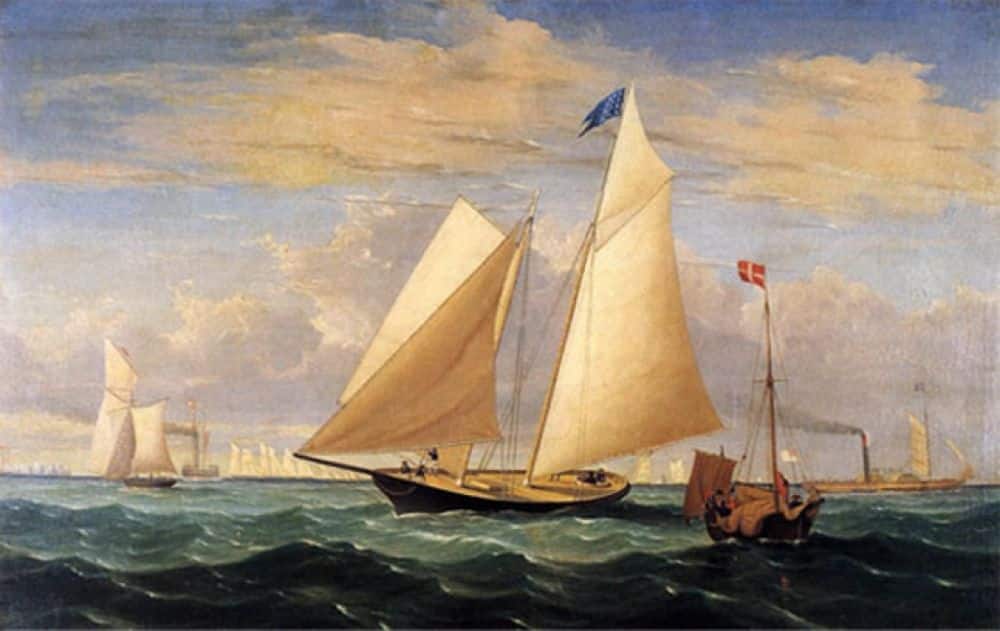
In 1851, the schooner America of New York Yacht Club sailed against 15 yachts of the Royal Yacht Squadron in the club’s annual regatta around the Isle of Wight. America finished 8 minutes ahead of the closest rival, securing victory, and beginning what would become one of the longest running competition in sports. in 1857, the Deed of Gift officially donated the America’s Cup to New York Yacht Club ensuring that it be held as a perpetual challenge trophy to promote friendly competition among nations.
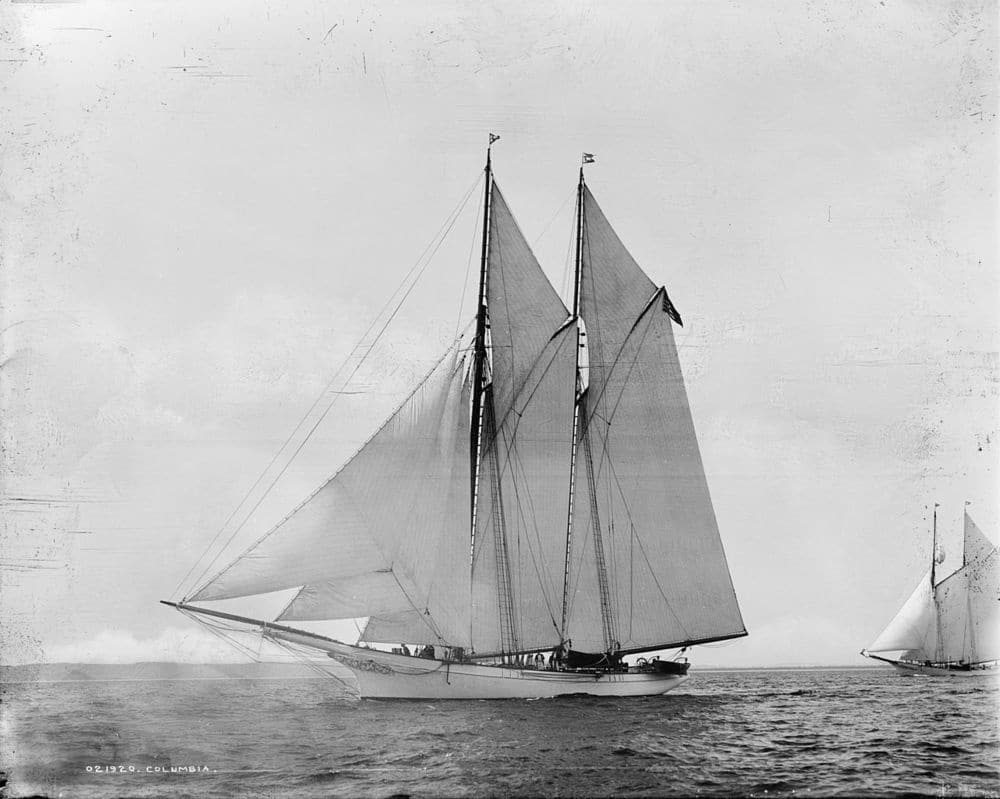
In 1871, the first official challenge to the America’s Cup came from James Lloyd Ashbury, who had previously beaten the schooner America and was emboldened by his victory. The New York Yacht Club accepted, and the schooner Columbia was chosen to defend, successfully taking the first two races before dismasting. The yacht Sappho was chosen as a replacement and continued to hold off the British challenge in the third and fourth races.
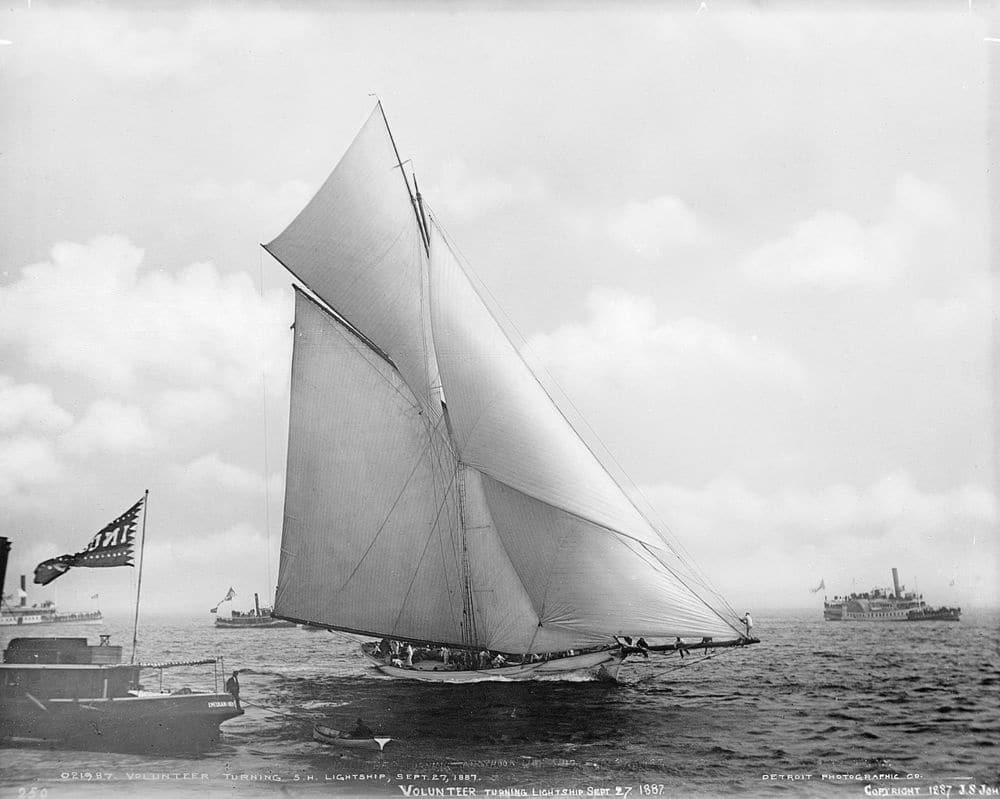
A new rule governing the design of America’s Cup yachts was drafted in 1885 after a series of Canadian challenges. Irish designer John Webb sent two yachts New York in 1885 and again in 1886 but neither could best the American designs. The final challenge under the New York Yacht Club Rule came in 1887, when Volunteer defended the Cup against the Scottish designed Thistle .
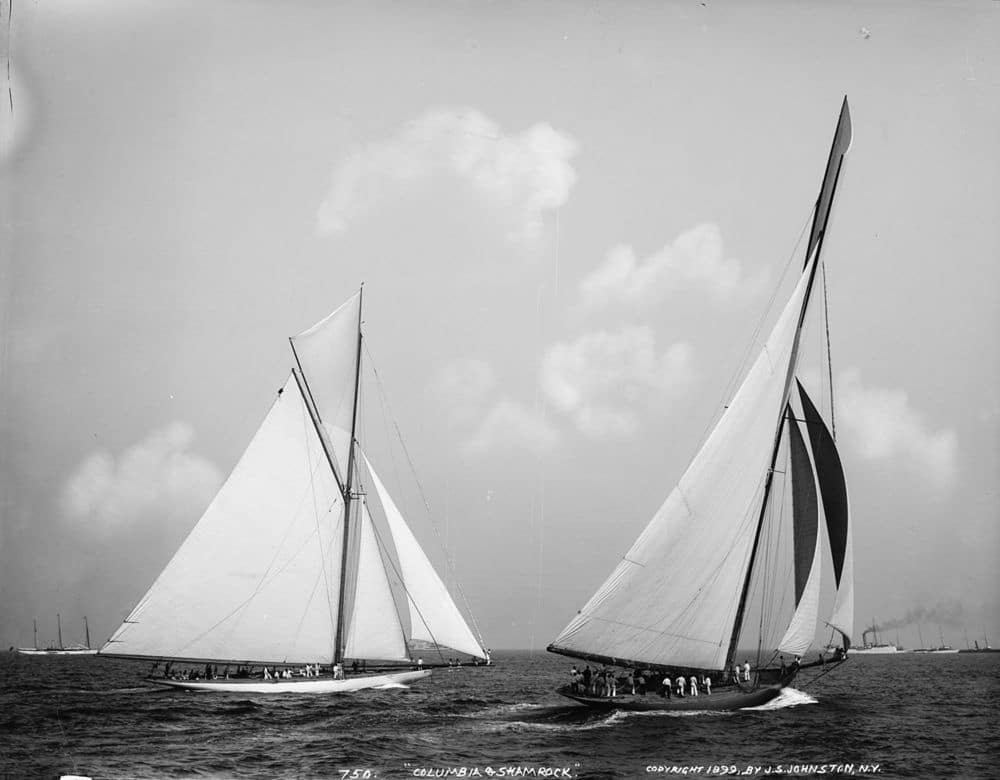
In 1889, the New York Yacht Club adopted the Seawanhaka Rating Rule. Over the next several years, Herreshoff designed boats would reign supreme, with Nathanael himself helming Vigilant to victory in 1893. In 1899, Sir James Lipton of Scotland posed the first of a series, racing Shamrock (right) against the already proven Columbia. Columbia , helmed by Charlie Barr, sailed to victory over Lipton, becoming the first yacht to defend the Cup more than once.
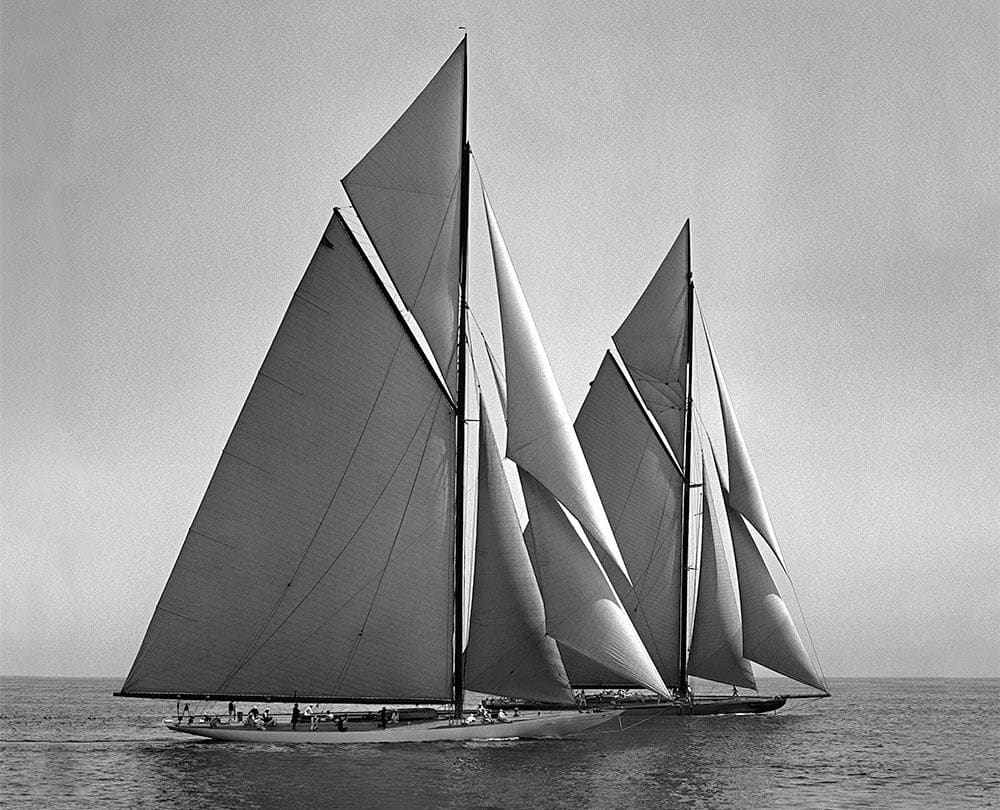
As Cup selection trials were underway for the 1914 challenge, war broke out and the Cup was cancelled, putting the first test of the newly implemented Universal Rule on hold. In 1920, the challenge resumed, with Lipton once again attempting to dethrone the Americans, this time with Shamrock IV . Lipton came the closest anyone had thus far in the event’s history to winning back the cup, winning the first two races, but the Herreshoff designed Resolute staged a comeback and went on to defend the cup for the Americans yet again.
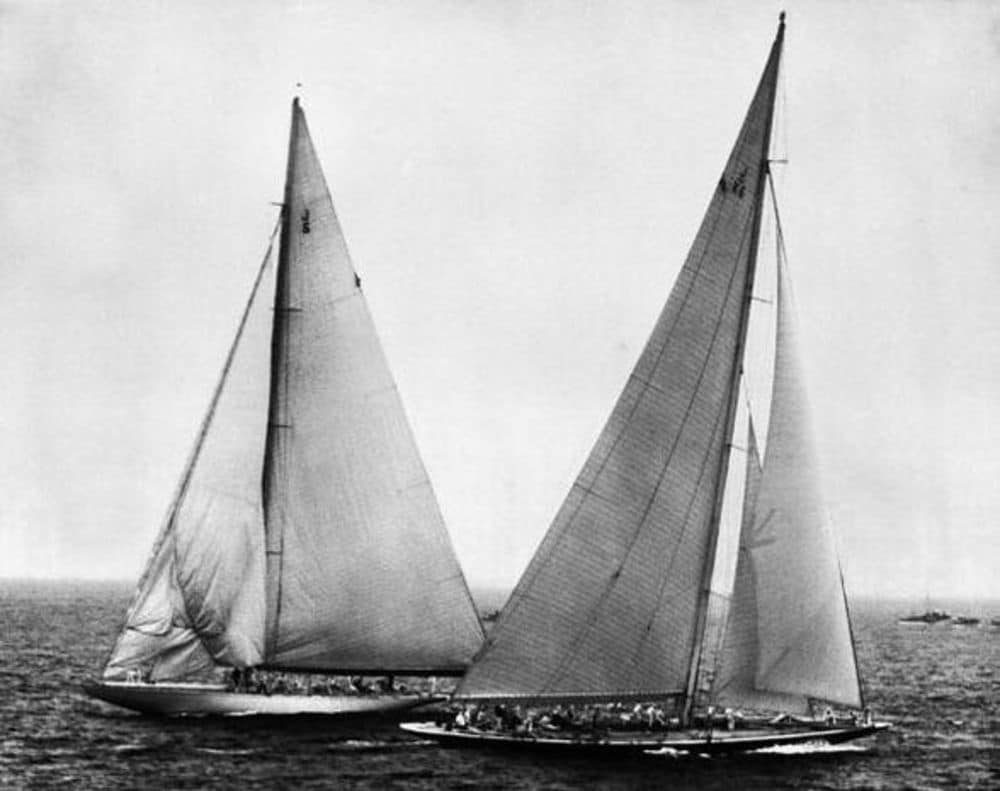
Lipton’s final America’s Cup challenge would come in 1929 in the J-Class. Shamrock V was heavy and outdated compared to Enterprise , which had little trouble in defeating the challenge. In 1934, having purchased Shamrock with the intent of challenging the cup, Sir Thomas Sopwith constructed Endeavor , and subsequently Endeavor II (right) for the challenge, but it was no match for Ranger (left).
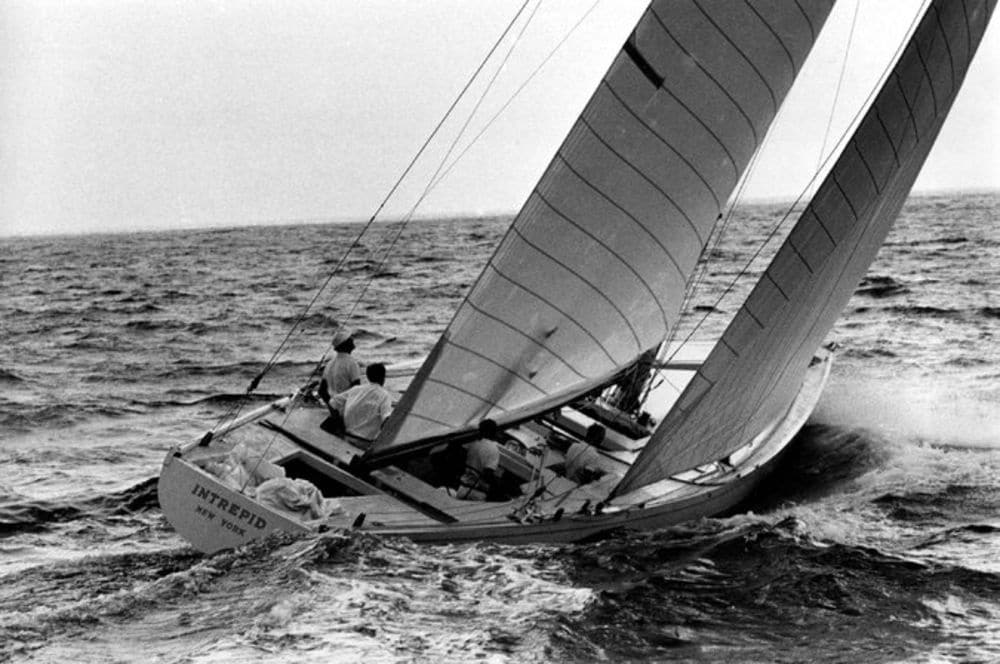
Following the second World War, the 12 Meter rule aimed to reduce the costs and ensure racing could continue in a post-war economy. The first unsuccessful challenge came in 1958, 20 years since the previous attempt by Endeavor II in the J-Class, with Columbia defeating the British challenger Sceptre . Over the next 20 years, the US would defend 7 more challenges, including the first Australian entry in 1962. Intrepid (pictured) would become just the second yacht in history to successfully defend the Cup twice, first in 1967, and again in 1970.
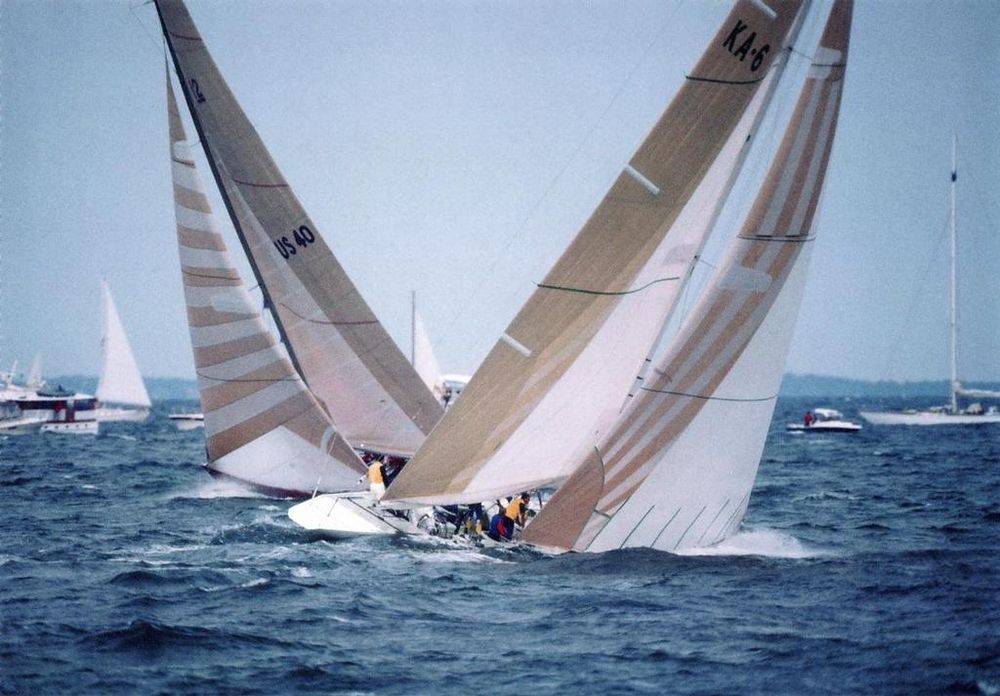
1983 would prove to be a historic and game-changing year for the history of the America’s Cup. Alan Bond, who had made three attempts already at bringing the cup to Australia, returned for a fourth attempt. The design of Australia II ‘s (right) keel was kept secret, and in the end, the infamous winged design would prove effective. Australia II overtook Liberty , despite initial problems, and went on to upend the longest winning streak in the history of sports – 132 years.
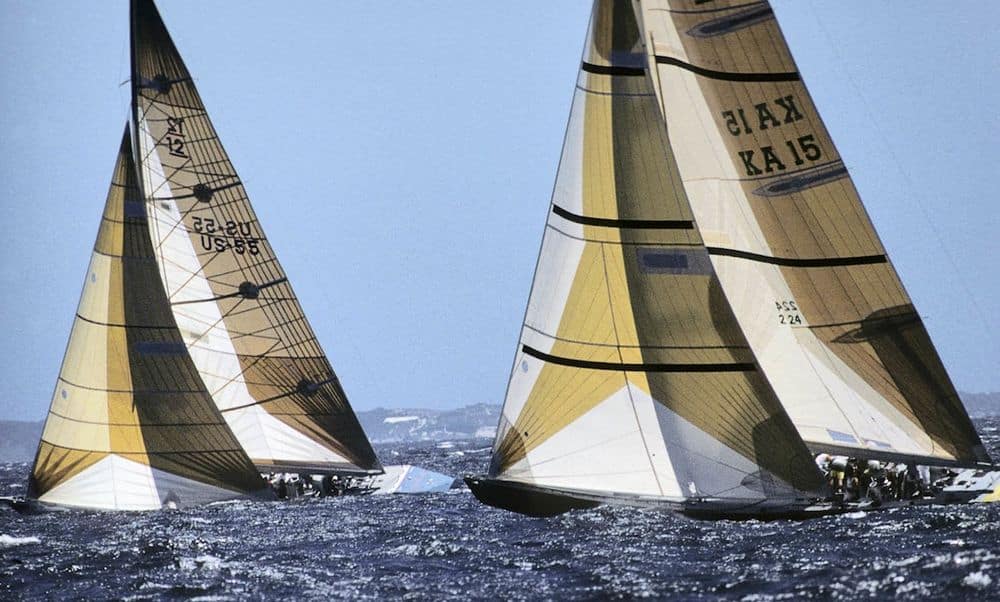
The first Cup defended outside of the United States was held in Fremantle Australia in 1987. From an unexpected field of 13 challengers, American Dennis Conner won the right to challenge the Australians through victory in the Louis Vuitton Cup. Conner easily sailed Stars & Stripes 87 to victory, beating Kookaburra III four races to zero, winning the cup back for the Americans.
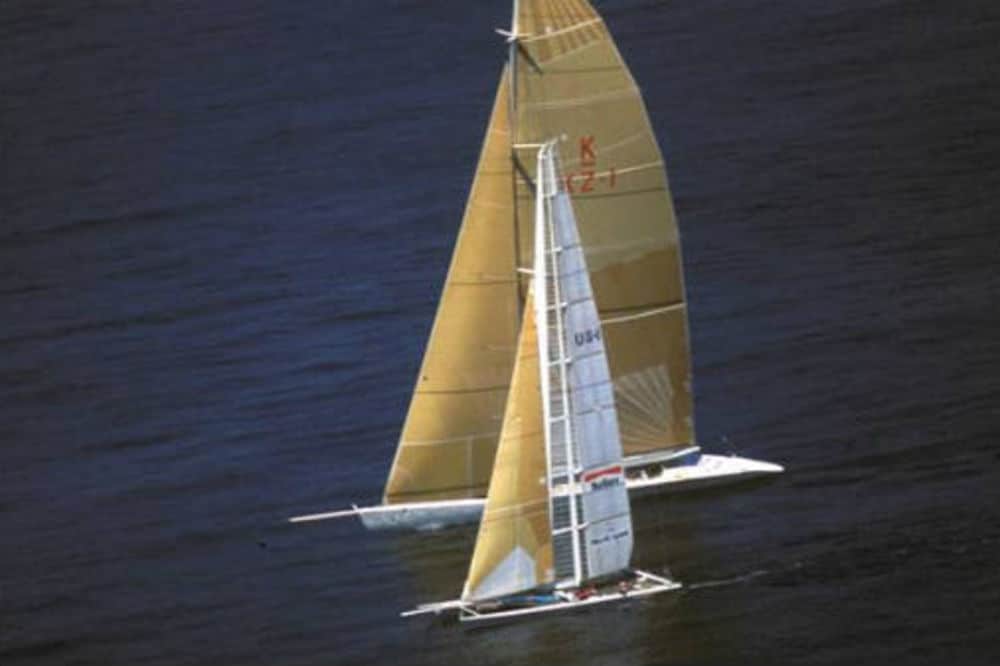
In 1988, an unexpected challenge came from a New Zealand syndicate, which proved to bring about major design changes and controversy never before seen in the America’s Cup. Conner, representing San Diego Yacht Club commissioned a catamaran to respond to the Kiwi challenge, realizing that multihulls were not expressly prohibited by the Deed of Gift. New Zealand’s “Big Boat” design, while cutting edge was inherently disadvantaged against Conner’s catamaran and lost by a significant margin.
After the race, controversy over the legality of the design in the Deed of Gift, and whether or not the spirit of “friendly competition” had been violated was rampant. Challenger Michael Fay took San Diego Yacht Club to court over the matter and was awarded the trophy in the ruling. The decision, however, was overruled and the cup was returned to the Americans.
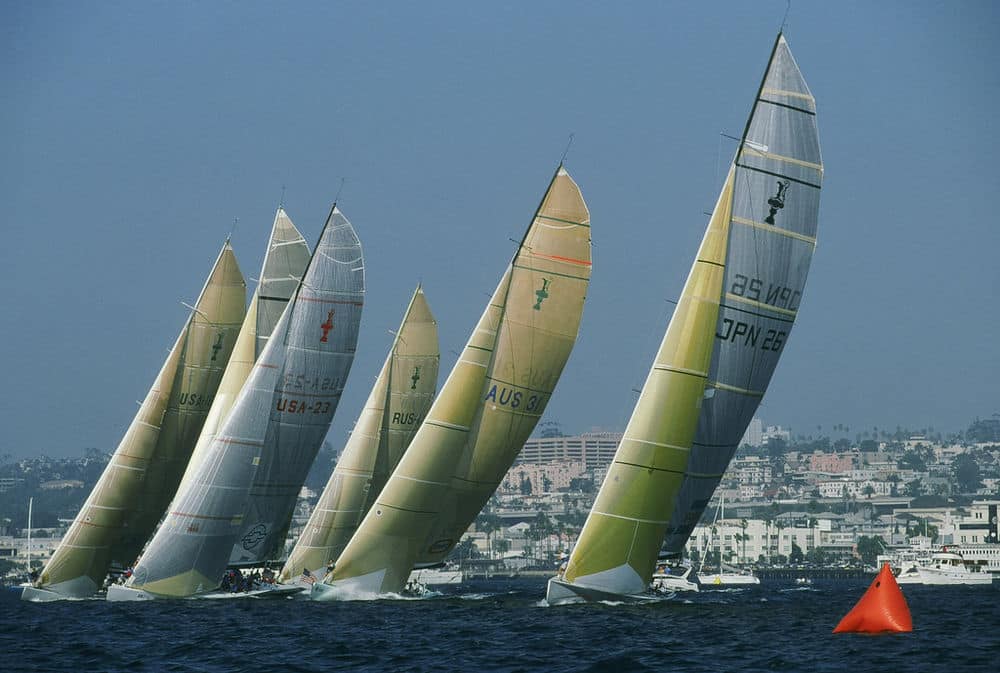
After the controversial 1988 Cup, a new design rule was put in place, and the International America’s Cup Class was born. From 1992 to 2007, the Cup changed hands regularly, with strong teams fielded by Italy, New Zealand and Australia. In the 1995 Cup in San Diego (pictured), New Zealand, skippered by Russel Coutts, scored their first victory, defeating Dennis Conner 5-0.
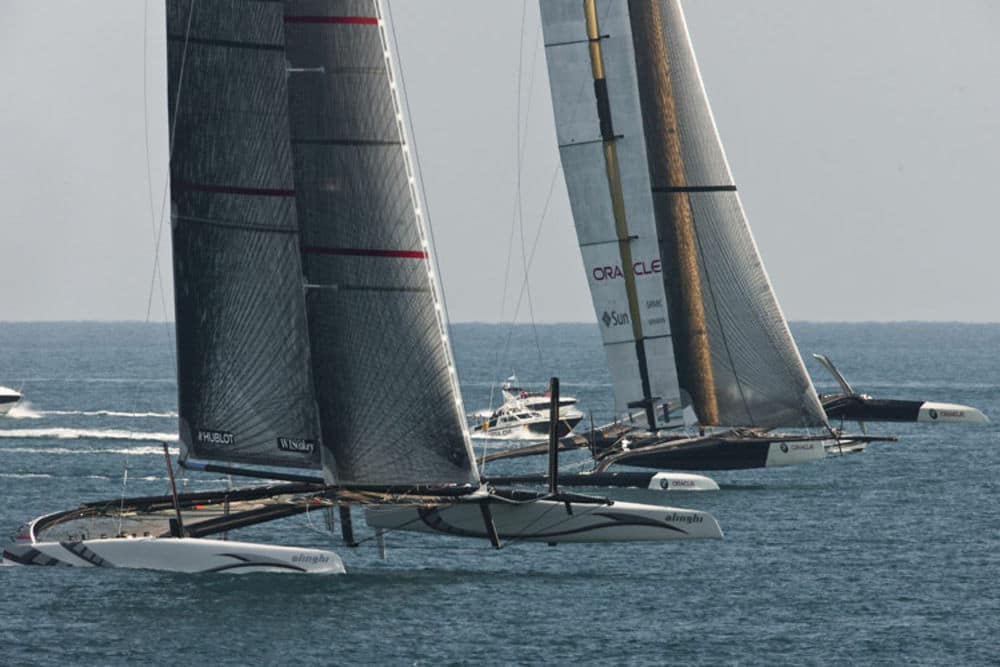
2010 brought more significant design changes to the cup, with BMW Oracle Racing challenging Alinghi in a battle of massive multihulls. BMW Oracle chose a trimaran with a rigid wing sail, similar to the sail used by Conner in the 1988 cup, while Alinghi chose traditional sails for their catamaran. The rigid wing proved to give BMW a significant advantage, and the Cup once again returned to the US.
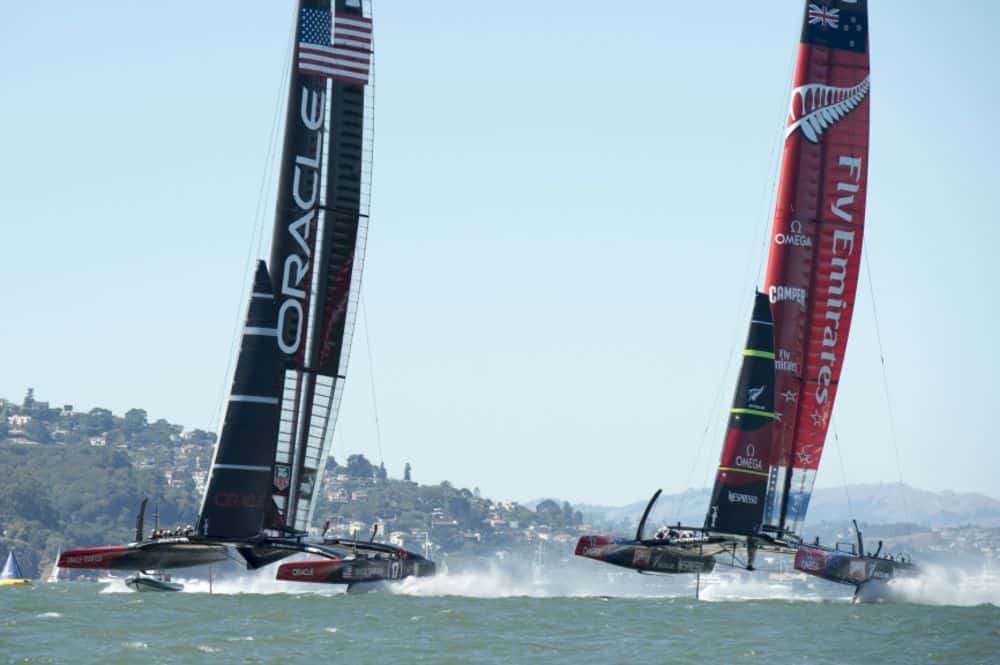
The 34th America’s Cup in 2013 brought about more changes to the America’s Cup class, with the defender, Oracle Team USA opting for the use of 72 foot catamarans for the racing on San Francisco Bay. The catamarans proved again to be a point of controversy over costs limiting the ability of teams to pose challenges, and the risk associated with the new, faster and more dangerous boats. Twice during training, major accidents occurred, and new safety regulations were put in place to ensure the safety of athletes.
Emirates Team New Zealand won the right to challenge Oracle in the finals, after defeating Artemis Racing and Luna Rossa in the Louis Vuitton Cup. In the final, New Zealand started strong, taking a commanding 8-1 lead, but the constant changes to crew and modifications to the boat allowed Oracle Team USA to fine tune their performance and turn the tide in their favor. In an epic comeback, Oracle overturned their 7 win deficit to beat Emirates Team New Zealand and secure the cup for America one again.
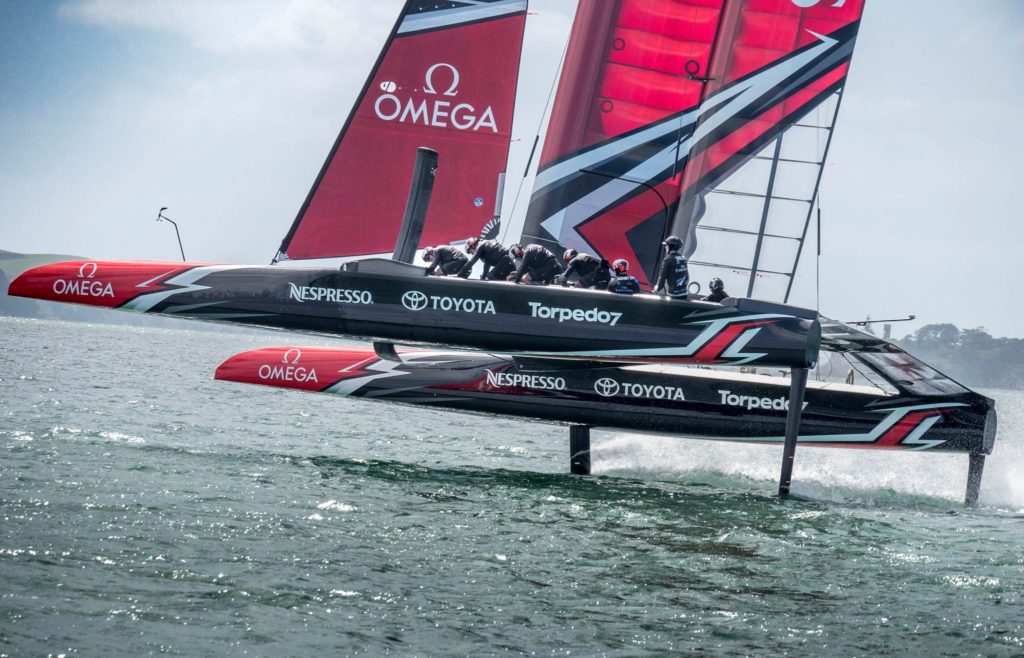
For the 35th America’s Cup in Bermuda, teams agreed to cut costs and improve safety and accessibility by reducing the size of the boats to just 50 feet. Training vessels were allowed, and the AC45F, a smaller, lighter foiling catamaran was selected as the platform for the America’s Cup World Series during 2016-2017. Teams have now launched their final race boats and training has begun for the start of the qualifier series.
In July, 5 teams will meet in Bermuda to battle for the right to challenge Oracle Team USA and determine the fate of the cup until the next challenge.
- More: america's cup , photos , racing , Sailboats
- More Sailboats

Pre-Owned: 1988 Hylas 47

Catalina Introduces the 6 Series

Sailboat Preview: Elan GT6 Explorer

For Sale: 1984 Camper & Nicholsons 58

Galápagos: A Paradise Worth the Paperwork

Around Alone

Grease the Wheels of Your Boat: A Guide to Proper Lubrication

A Bowsprit Reborn: A DIY Renovation Story
- Digital Edition
- Customer Service
- Privacy Policy
- Terms of Use
- Email Newsletters
- Cruising World
- Sailing World
- Salt Water Sportsman
- Sport Fishing
- Wakeboarding
The Evolution of Yachting at The America’s Cup Finals
From sir thomas lipton’s shamrock v to the newly launched svea, the 35th edition of the america’s cup is bringing together the biggest fleet in the history of the j class to race in the waters off bermuda..
The evolution of yachting will be televised this year—the hydro foiling cats will be bombing around the cans and the J-Class, which competed for the cup throughout the 1930’s, will bring back the spirit of the one design class challenging for the ‘Chart’.
The original winner of The America’s Cup in 1851, “America”, was the boat that gave the trophy its name. It was a 101 foot monohull schooner which carried over 5,400 square feet of sail, and the golden years of the Cup with the J’s.
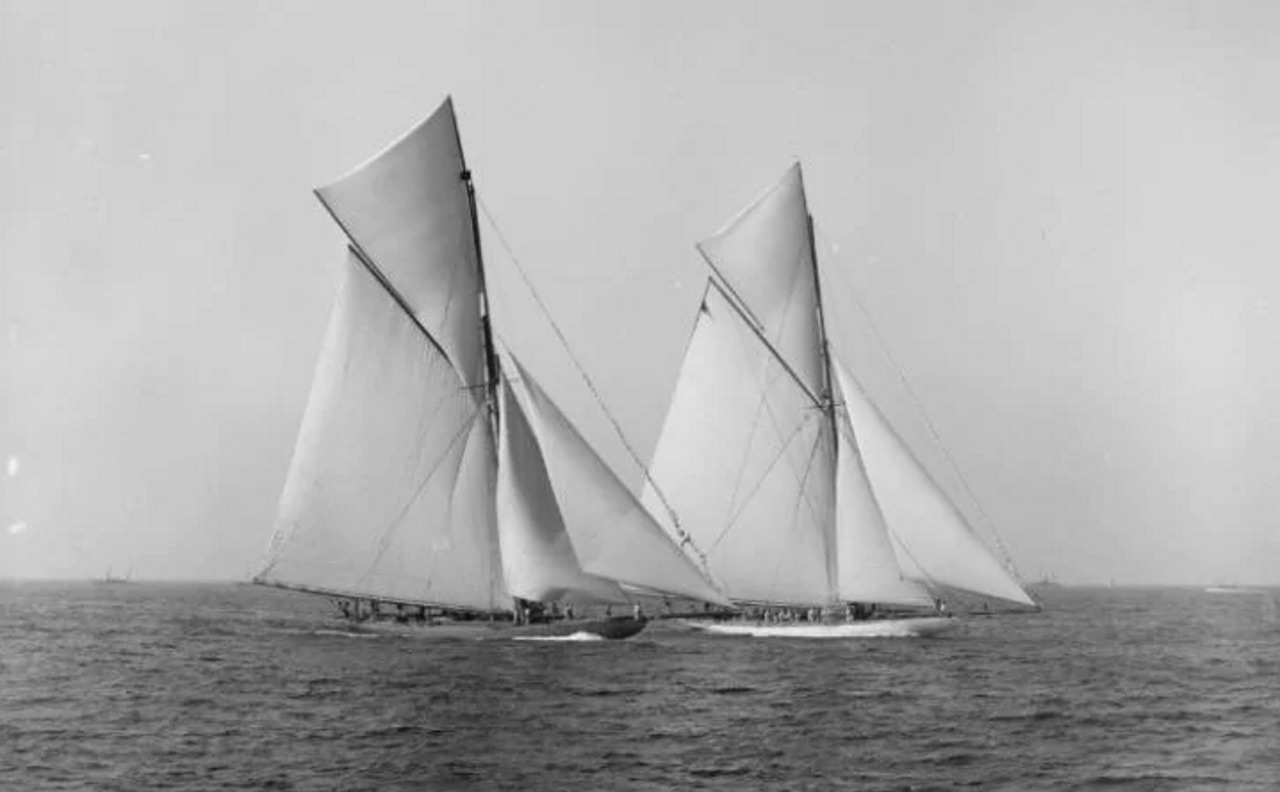
Technology and development has been a big part of the America’s Cup since the beginning—and this year’s cup is no different as teams search for any advantage to get that extra knot of speed.
In terms of evolution, the boats themselves are controversial, yet innovative, changing the AC Class of boat by two-folds.
[gallery type="rectangular" size="full" ids="8339,8341"]
In contrast is the America’s Cup Class, a 50 foot long carbon fibre catamaran featuring a wingsail and hydrofoiling technology that enables the boats to fly above the water. This is achieved by the boat being lifted above the water by a carbon fibre fin about the size of a 5’2 fish known as a foil. As the boat speeds up, they lift out of the water.
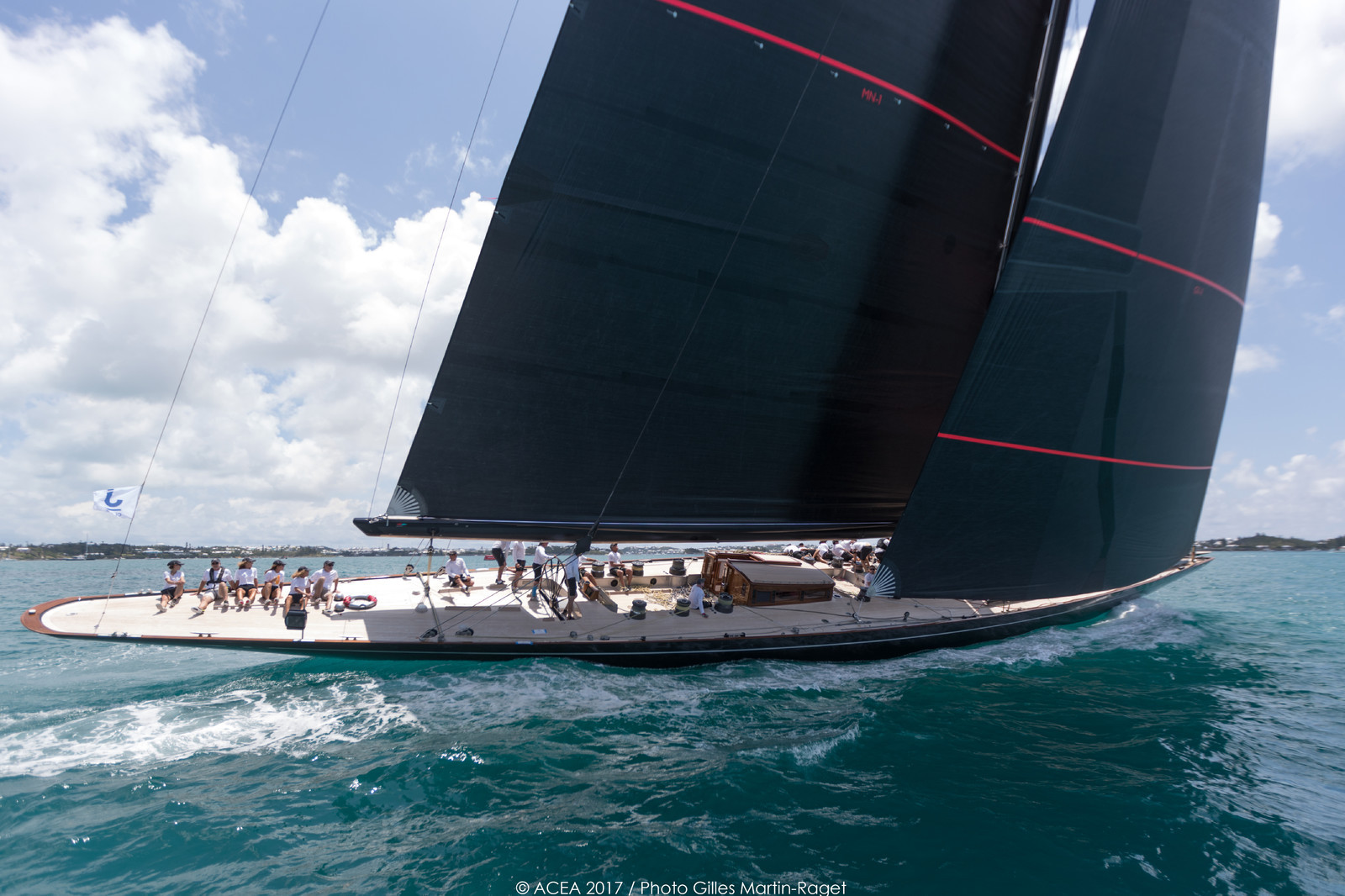
Using the lift generated by the daggerboards and rudders, the game is to keep the hull above the water line, sailing on a set of carbon-fiber foils that give enough lift to have the boat looking at fly time hitting speeds of up to 50 knots, which has come a long way from the Schooner America, the J Class and the monohulls of the 80’s and 90’s.
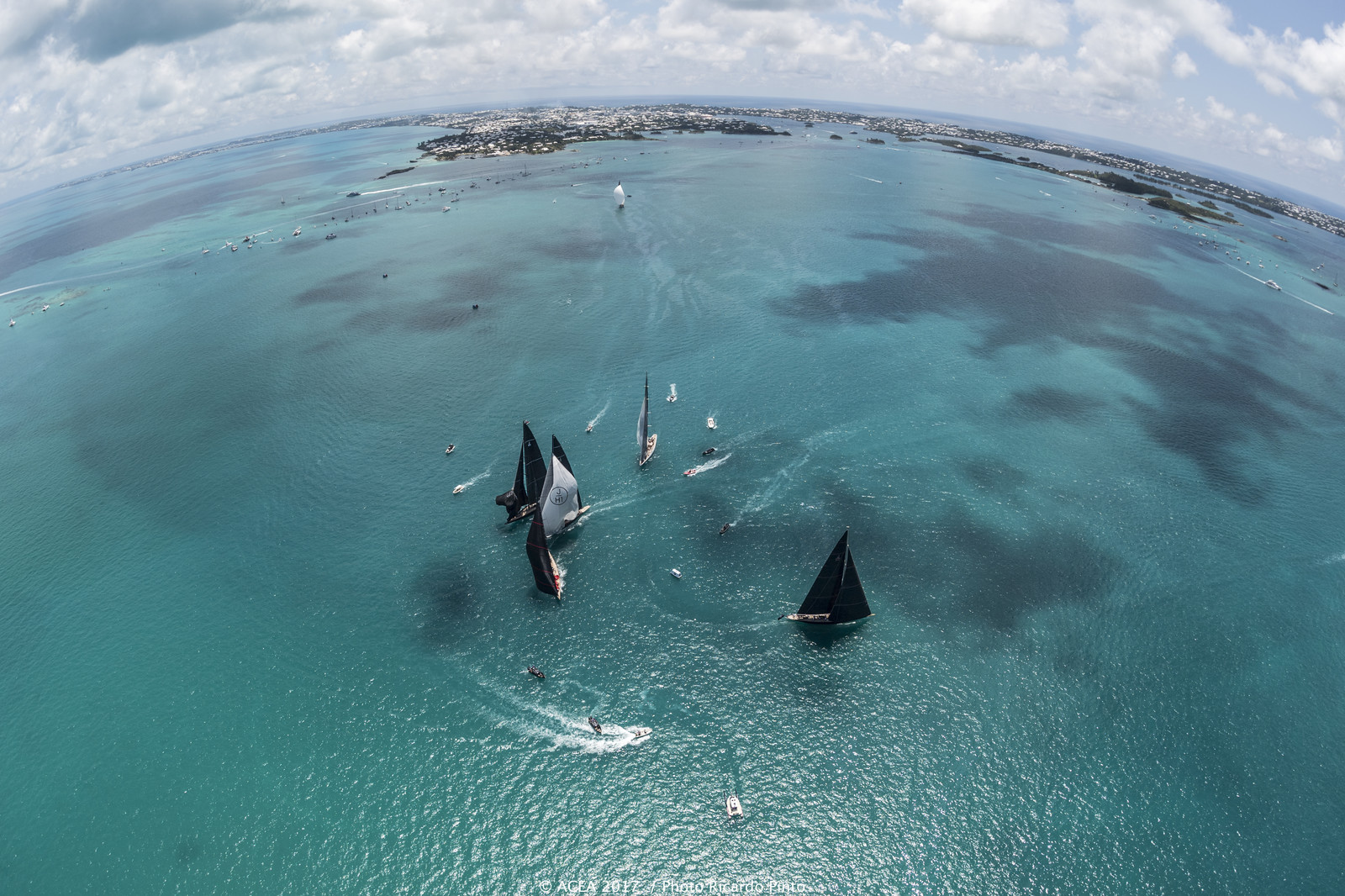
The clear waters of Bermuda will have an evolution that, in design, has changed, but with the tactics remaining the same. From the J’s to the AC’s, we are looking at a month’s sailing that for the spectator, professional and novice alike, will showcase an ocean of history in the water.
With the contest for the cup already begun, the challengers have been fighting it out in a one-on-one knockout series of sailing, with it coming down to the playoffs final with Emirates Team New Zealand and ‘The Swedes’ Artemis racing, with helmsman Peter Burling’s Emirates coming out on top.
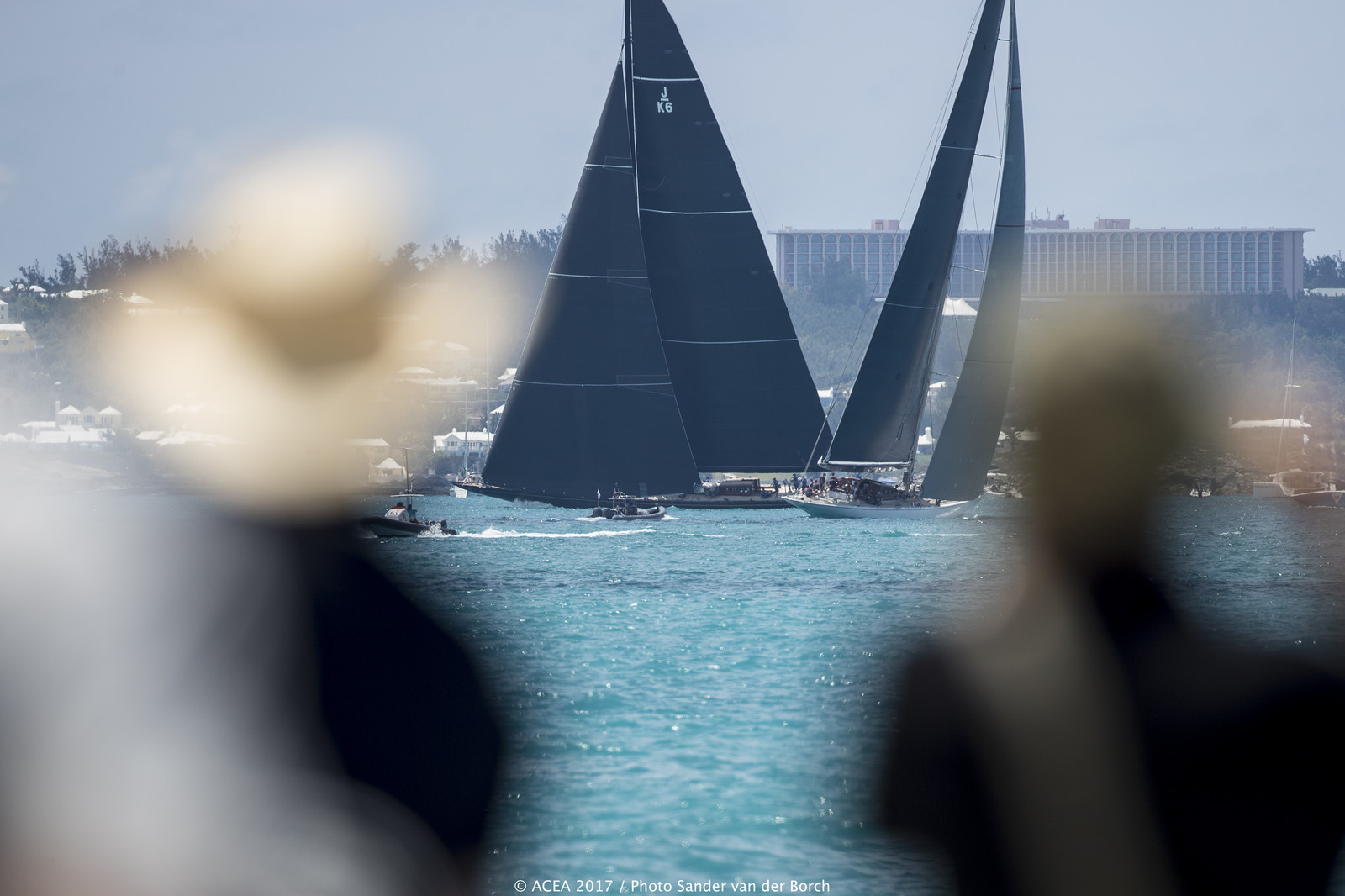
The teams are now challenging for the oldest trophy in sport, with the team to beat being cup holders ‘the’ Oracle Team USA.
The next days of sailing are going to be epic!
The next round of races take place June 24th-27th and The Outdoor Journal is on the island and in the sheds to bring you some of the action from the water, with updates on the boats and a bit of behind the scenes beers and discussions of the days racing with the captains and crews. Stay tuned!
35th Americas Cup - The Finals: Oracle Team USA the holders Emirates Team New Zealand the challengers
Americas Cup J Class Regatta The line-up for the J’s is an amazing 7 boats, Being the biggest fleets of boats in the history of the class.
JK3 Shamrock V 1930 JK7 Velsheda 1933 J5 Ranger 2004 JK6 Hanuman 2009 JH1 Lionheart 2010 J8 Topaz 2015 JS1 Svea 2016
For more information, head to the America's Cup website .
Feature image by Ricardo Pinto / America's Cup Match
Sweden to Kill Nearly 500 Brown Bears This Year
Sea shepherd founder paul watson arrested in greenland, eco-warriors behind the lens: photographers leading the charge in marine conservation.
Visit our Museum Store for ALL NEW G IFT ITEMS!

City Island and the America’s Cup
The America's Cup is the oldest international sporting trophy. In 1851, the yacht America beat the best of the British fleet during the World's Fair and won a sterling silver trophy that would become known as the America’s Cup (named after the yacht, not the country). The first official challenge took place in 1870 in New York Harbor and was won by the American yacht Magic (the aging America finished fourth). Originally built in 1857 in Philadelphia, Magic had been completely rebuilt by David Carll in 1869 (lengthened and widened with increased draft) and converted to a centerboard schooner before winning the first defense of the America’s Cup. And thus began the longest winning streak in the history of sport, a 132-year stretch of domination that saw boats representing the United States successfully defend the trophy 23 more times through 1980—until 1983, when Australia II became the first successful challenger to lift the trophy.

During the 1890s, many of the America’s Cup defenders, contenders, and challengers, including Vigilant, Defender, and Columbia, plus Shamrocks I and II, were serviced and stored at City Island by both the Hawkins and Piepgras yards.
During the first half of the 1900s, the America’s Cup defender Reliance was serviced, stored, and ultimately broken up at the Robert Jacob Shipyard. Defiance and Vanitie were serviced at City Island yards, and the challengers Shamrock III and IV were also serviced and stored at the Jacob yard.
From 1903 to 1958, every America’s Cup defender carried an inventory of Ratsey & Lapthorn sails, including Reliance (1903), Resolute (1920), Enterprise (1930), Rainbow (1934), Ranger (1937), and Columbia (1958).
In addition, between the 1890s and 1980, alterations, rigging work, and new spars were provided for the contenders by many City Island concerns, including Hawkins, Piepgras, B. F. Wood, Robert Jacob, Ratsey & Lapthorn, Henry B. Nevins, Charles Ulmer, and Kretzer Boat Works.
Between the years 1935 and 1980, twenty 12-meter yachts were built in America, twelve of them at City Island. Eight were contenders for America’s Cup defense (Vim 12 US/15, Columbia 12 US/16, Constellation 12 US/20, Intrepid 12 US/22, Courageous 12 US/26, Enterprise 12 US/27, Independence 12 US/28, and Freedom 12 US/30). Of these, five were defenders in seven America’s Cup campaigns, Columbia in 1958, Constellation in 1964, Intrepid in 1967 and again in 1970, Courageous in 1974 and again in 1977, and Freedom in 1980.
The 110-year string of 24 successful campaigns to defend the Cup began with Magic, completely rebuilt on City Island in 1870, and ended with Freedom, built on City Island in 1980. Ironically, in 1983, when City Island had no connection with the defender, America suffered her first loss.


Yachting World
- Digital Edition

WATCH: Will the USA’s Radical America’s Cup Design Choices Pay Off?
- Toby Heppell
- August 14, 2024
America's Cup designer, Thomas Tison of Thomas Tison Yacht Design & Engineering, speaks to Yachting World editor, Helen Fretter, about the New York Yacht Club's America's Cup boat. Will Patriot's radical design choices pay off?

American Magic’s new AC75 , Patriot , has garnered significant attention due to its unique approach. While all the teams are bound by the same set of design rules, it’s the subtle variations and innovative interpretations within these boundaries that could determine who ultimately claims victory at the America’s Cup in Barcelona.
The second generation of AC75s have seen incremental improvements across the board, yet American Magic’s Patriot stands out for several reasons. The American team has made some bold design choices that diverge from the more conventional paths taken by their rivals. Central to these decisions is the team’s focus on maximising aerodynamic efficiency and optimising the boat’s centre of effort.
One of the most noticeable aspects of Patriot is its distinct hull design. Unlike other teams that have opted for more rounded, voluminous hulls, American Magic has taken a different route, creating a sleeker, lower-volume hull. This design is intended to reduce drag and increase the boat’s ability to generate lift, potentially giving Patriot an edge in lighter wind conditions.
The lower freeboard— the distance between the deck and the waterline — also allows the team to increase sail area close to the water, which can generate more driving force with less windage.
Another key innovation lies in the way American Magic has managed weight distribution. The team has worked diligently to reduce weight in critical areas, thereby allowing for more complex systems elsewhere on the boat. This includes the trimming systems, which are battery-powered and play a crucial role in adjusting the foils and sails during racing.
Article continues below…

Watch: The Design Secrets of Alinghi Red Bull Racing’s America’s Cup boat
As the sailing world eagerly counts down to the 37th America’s Cup, the spotlight in recent months has been on…

Watch: Is this the boat to end 170 years of British America’s Cup hurt?
The pursuit of the America’s Cup, the pinnacle of competitive sailing, has long been a storied journey for Britain. With…

Watch: Emirates Team New Zealand’s America’s Cup boat innovations
The 37th America’s Cup in Barcelona this autumn is getting ever closer, something marked by all teams launching the boat…

Watch: Luna Rossa Prada Pirelli’s America’s Cup Boat Innovations
The 37th America’s Cup in Barcelona this autumn is getting ever closer, and as the event heaves into view we are…
By optimising weight distribution, Patriot is designed to achieve a balance between stability and performance, particularly in choppy conditions like those expected off the coast of Barcelona.
The decision to use recumbent cyclists (cyclors) as the primary source of power for these systems also reflects American Magic’s willingness to experiment. While this choice has sparked some debate — given the lower energy output compared to more traditional grinding positions — the team believes that the aerodynamic gains and lower centre of gravity provided by the recumbent position outweigh the potential drawbacks.
Furthermore, Patriot features innovative foil designs that could offer a competitive edge. The team has focused on optimising the flaps at the back of the main foil, allowing for more precise control of lift and drag. This, combined with the overall aerodynamic improvements, could enable Patriot to achieve higher speeds and better maneuverability in various wind conditions.
However, with these bold choices comes significant risk. The question remains: will these radical design decisions translate into a performance advantage on race day? The true test will come when Patriot lines up against its competitors, where every nuance of design and strategy will be put to the ultimate challenge.
In the unpredictable world of America’s Cup racing, innovation often walks a fine line between triumph and disaster. Whether Patriot’s unique design will give the USA the edge it needs to reclaim the Cup remains to be seen, but one thing is certain, American Magic has made a statement that they are not afraid to push the boundaries in their quest for victory.
If you enjoyed this….
Yachting World is the world’s leading magazine for bluewater cruisers and offshore sailors. Every month we have inspirational adventures and practical features to help you realise your sailing dreams. Build your knowledge with a subscription delivered to your door. See our latest offers and save at least 30% off the cover price.

Select up to 10 swatches. Limit of one swatch of the same pattern/color per order. Charges may apply for non-fabric swatches.
- bvseo_sdk, java_sdk, bvseo-3.1.1
- CLOUD, getContent, 60ms
- REVIEWS, PRODUCT
- bvseo-msg: The resource to the URL or file is currently unavailable.;
- CLOUD, getContent, 61ms
- QUESTIONS, PRODUCT


IMAGES
VIDEO
COMMENTS
Columbia was an American racing yacht built in 1899 for the America's Cup races. She was the defender of the tenth America's Cup race that same year against British challenger Shamrock [1] as well as the defender of the eleventh America's Cup race in 1901 against British challenger Shamrock II.She was the first vessel to win the trophy twice in a row [2] (a record not equaled until Intrepid ...
Some say Columbia was modelled on the Burgess-designed Puritan, a promising contender that met a premature end on the foggy shores of Sable Island in Nova Scotia.Built for $35,000, Columbia was to go after cup defender Bluenose, a 43.59 metre Canadian-built schooner with a daredevil of a captain, Angus Walters. At the hands of her equally determined skipper, Ben Pine, Columbia came very close ...
Columbia, a New York Yacht Club defender, swept the Royal Yacht Squadron challenger Sceptre 4-0 in the first America's Cup race in the new class of smaller and faster sloops. Learn about the history, design, and legacy of the 12-meter class boats and the 1958 regatta.
Columbia was designed by Olin Stephens and built by Nevins.Built to compete for the right to defend the '58 America's Cup, she was owned by a syndicate headed by New York Yacht Club members Henry Sears, Gerard B. Lambert, Briggs Cunningham, Vincent Astor, James A. Farrell, A. Howard Fuller, and William T. Moore.. Columbia was helmed by Cunningham, the inventor of the cunningham downhaul, with ...
Columbia is the first 12 Meter yacht to win the America's Cup in 1958, designed by Olin Stephens and skippered by Briggs Cunningham. She is a fast, sleek and beautiful boat that offers racing or pleasure sailing charters in New England.
Prior to 1958, the last defense of the America's Cup had been in 1937, by the J-Class yacht Ranger, owned by Harold S. "Mike" Vanderbilt. The J-Class rules prescribing a vessel of some 120 feet in length were promoted by Vanderbilt and others for the defense planned for 1958, but economic concerns and the desire among aspiring competitors ...
Learn about the origins, evolution and highlights of the America's Cup, the oldest and most prestigious sailing trophy in the world. The web page covers the key events, classes, challenges and controversies from 1851 to 2021.
Shamrock" and "Erin" sailing The Shamrock is seen after its defeat in the 1899 America's Cup, along with Sir Thomas Lipton's steam yacht Erin, which served as its tow boat and tender across the Atlantic. Contributor: American Vitagraph Company - Smith, Albert E. (Albert Edward) - Blackton, James Stuart - Niver (Kemp) Collection (Library of Congress) - Thomas A. Edison, Inc - Paper Print ...
"The decisive moment in the great International Yacht Races is shown in this picture. Against a background of well defined clouds, the light boat is seen marking the finishing line in this great aquatic struggle. As the Columbia crosses the line, followed closely by the Shamrock, we see the steam from the whistle of the light ship announcing the well earned victory of the American yacht ...
Columbia was an American racing yacht built in 1899 for the America's Cup races. She was the defender of the tenth America's Cup race that same year against British challenger Shamrock as well as the defender of the eleventh America's Cup race in 1901 against British challenger Shamrock II.She was the first vessel to win the trophy twice in a row (a record not equaled until Intrepid ' s back ...
The 1899 America's Cup was the 10th challenge for the Cup. It took place in the New York City harbor and consisted of a best of five series of races between the defender, Columbia, entered by the New York Yacht Club, and Sir Thomas Lipton's Shamrock, representing the Royal Ulster Yacht Club. Columbia won all three races against Shamrock.. Guglielmo Marconi transmitted the event on radio from ...
The America's Cup of 1899 took place in New York City harbor.The Race was between the defending yacht Columbia owned by J.P. Morgan and the challenging yacht...
America's Cup Yacht "Columbia" by admin in America's Cup Yacht , Herreshoff , Herreshoff AC Yacht , Latest Classic Yacht News on Posted on April 10, 2013 October 15, 2014 LOA: 131′ 0″
Learn about the origins, rules and evolution of the America's Cup, the oldest and most prestigious sailboat trophy in the world. Discover how Newport, Rhode Island hosted the races from 1930 to 1983 and how the 12 Meter yachts dominated the competition.
Columbia, US-16 is a historic racing yacht that won the America's Cup in 1958 and participated in several other regattas. Learn about her history, specifications, owners and achievements on the International 12 Metre Class Association website.
The America's Cup Hall of Fame was founded in 1992 under the auspices of the Herreshoff Marine Museum by Halsey Herreshoff, ... Columbia/Sappho ... The yacht AMERICA won the Royal Yacht Squadron ₤100 Cup on August 22nd, 1851. Her surviving owners presented the Cup to the New York Yacht Club in 1857 under the condition that it serves as a ...
J Class yachts are synonymous with the America's Cup as these slim, graceful beauties once represented the fleet racing for the Cup. The 36.42 metre Shamrock V, commissioned by Sir Thomas Lipton for his fifth and final bid, she was the first J Class yacht to compete for the Cup. The fact that she is the only J Class yacht to be built in wood ...
Columbia defends the America's Cup before losing a mast during race three. US Library of Congress. In 1871, the first official challenge to the America's Cup came from James Lloyd Ashbury, who had previously beaten the schooner America and was emboldened by his victory. The New York Yacht Club accepted, and the schooner Columbia was chosen to defend, successfully taking the first two races ...
Sir Thomas Lipton's Shamrock I and JP Morgan's yacht Columbia, maneuvering for the start of the America's Cup race, October, 1899. Photo from Getty Images. Technology and development has been a big part of the America's Cup since the beginning—and this year's cup is no different as teams search for any advantage to get that extra knot of ...
Between the years 1935 and 1980, twenty 12-meter yachts were built in America, twelve of them at City Island. Eight were contenders for America's Cup defense (Vim 12 US/15, Columbia 12 US/16, Constellation 12 US/20, Intrepid 12 US/22, Courageous 12 US/26, Enterprise 12 US/27, Independence 12 US/28, and Freedom 12 US/30). Of these, five were ...
America's Cup designer, Thomas Tison of Thomas Tison Yacht Design & Engineering, speaks to Yachting World editor, Helen Fretter, about the New York Yacht Club's America's Cup boat.
Our America's Cup Columbia 1901 Boat Model is a detailed model of the America's Cup 4-time winner, Columbia. This version represents the 1901 winner, with her towering mast, boom, gaff, and bowsprit, and beautiful cotton sails. Whether you choose the smaller model for a desktop, or the large hotel lobby size, this exquisite classic sailing ship adds a truly unique feel to your indoor decor ...
American Magic of the New York Yacht Club started the day by losing to Luna Rossa before bouncing back by edging Orient Express to reach 4-4. ... series will start on Sept. 14 to decide which challenger will claim the Louis Vuitton Cup and earn a place in the America's Cup match, where it will face holder Emirates Team New Zealand in October ...
The 1901 America's Cup was the 11th challenge for the Cup. It took place in the New York City harbor and consisted of a best of five series of races between the defender Columbia, entered by the New York Yacht Club for the second time, and Sir Thomas Lipton 's Shamrock II, representing the Royal Ulster Yacht Club.
Columbia was one of the two yachts to successfully defend the second America's Cup race in 1871 against English challenger Livonia. Design [ edit ] Columbia was a wooden centerboard schooner designed and built in 1871 by J. B. Van Deusen in Chester, Pennsylvania for owner Franklin Osgood of the New York Yacht Club . [1]
The 37th America's Cup is about to get underway, with the Royal New Zealand Yacht Squadron aiming to defend the title they won four years ago in Auckland.. They will face determined challengers, though, as all eyes turn towards the most prestigious sailing competition and one of the world's oldest sporting events.. Here is everything you need to know before things begin.